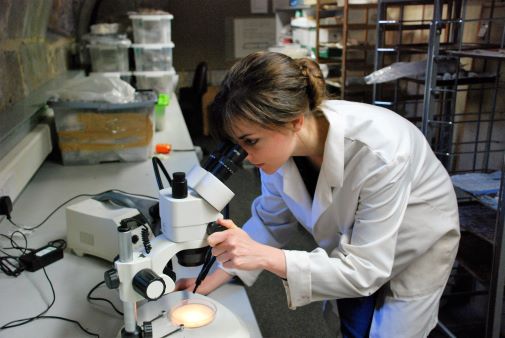Scientists unearth forgotten children of the past
Posted on 17 May 2023
 One of the team of scientists analysing hair under the microscope
One of the team of scientists analysing hair under the microscope
A team from the University of York in collaboration with the Durham University and volunteer researchers at Washburn Heritage Centre, examined human remains from a rural churchyard cemetery in the village of Fewston, North Yorkshire.
Analysis
The analysis discovered the skeletal remains of over 150 individuals, including an unusually large proportion of children aged between eight and 20 years.
Early analysis immediately identified the children as being distinctive from the locals, showing signs of stunted growth and malnutrition, as well as evidence of diseases associated with hazardous labour.
The team of scientists, working together with local historians, have been able to piece together the story of these forgotten children, transported from workhouses in London and indentured to work long hours in the mills of the North of England. They were used as an expendable and cheap source of labour.
Impact of poverty
The scientific analysis combined many different approaches and provides a direct and compelling testimony of the impact of poverty and factory labour on children’s growth, health and mortality in the past.
Professor Michelle Alexander, from the Department of Archaeology at the University of York, who was a senior author of the study, said: “We undertook chemical analysis of the bones to study diet and found that the apprentices had a lack of animal protein in the diet compared to the locals, more on a level with the victims of the Great Irish Famine.”
Examination of the bones and teeth also highlighted the large numbers of pathologies, including tuberculosis and respiratory disease associated with millwork, diseases of deprivation, such as rickets, and the delayed growth of the children.
Hardships
Professor Rebecca Gowland, from Durham’s Department of Archaeology, said: “This is the first bioarchaeological evidence for pauper apprentices in the past and it unequivocally highlights the toll placed on their developing bodies.
“To see direct evidence, written in the bones, of the hardships these children had faced was very moving. It was important to the scientists and the local community that these findings could provide a testimony of their short lives."
The remains have now been reburied in a ceremony that involved contributions from the local community, volunteer researchers, scientists and descendants of those excavated.
Industrial past
Sally Robinson from the Washburn Heritage Centre, Yorkshire, who led the team of local volunteers said: “It's easy to forget that the Washburn valley had an industrial past given the beauty of the reservoirs that visitors see today.
“It was important to us to find out about the children who worked in the mills. They were overlooked in life and treated as a commodity - but we hope we have done them some justice by telling their stories and creating a lasting commemoration.”
Artwork inspired by the analysis and an exhibition are now on permanent display at the Washburn Heritage Centre.
Excavation
Malin Holst, from the University of York’s Department of Archaeology, said: "This project was very rewarding, as we worked closely with the Fewston community and descendants of the dead from the initial excavation to the publication.
“We researched the named individuals in depth and obtained photos, birth and death certificates, psychiatric records and personal diaries.
“This, together with our scientific research provided an insight into the daily lives of this cemetery population - the stone masons, farmers, housewives, labourers and the pauper apprentices who worked in the mills.”
The research, funded by the National Lottery Heritage Fund, is published in the journal PLOS ONE.
Explore more news

Sodium channels in breast cancer cells a promising target for future treatments, study reveals
Thursday 25 July 2024

Cooling the classroom: University of York researchers to investigate UK schools’ responses to hot weather
Wednesday 24 July 2024

Hunter-gatherers kept an 'orderly home' in the earliest known British dwelling, study shows
Tuesday 23 July 2024

Study uses Game of Thrones to advance understanding of face blindness
Tuesday 23 July 2024

York academic contributes to new report on men’s health which reveals disparities between most and least deprived areas in the UK
Wednesday 17 July 2024
Media enquiries
About this research
Researchers examined human remains from a cemetery in North Yorkshire, with a large proportion identified as children aged between eight and 20 years, who had been transported from workhouses in London to mills in the North of England.
The research, funded by the National Lottery Heritage Fund, is published in the journal PLOS ONE.
